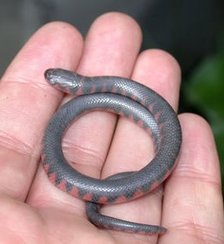Hoop snakeA legendary snake of North America and Australia |

Custom Search
|
|
With our amazing imagination, it's no surprise that we come up with many mythical creatures, and the world of snakes is no exception. One such myth is that of the hoop snake, a legendary snake found in the American, Canadian, and Australian folklore and tall tales.
This is one of the most persistent and widespread snake myths of the United States, with sightings of hoop snake being reported since colonial times in North America. Up to this day sightings of the hoop snake are still being occasionally reported, even though the scientific community has never accepted their existence. Raymond Ditmars a Naturalist even placed $10,000 in a trust at a New York bank as a prize to be given to the first person providing evidence of the existence of hoop snakes. Quite disappointingly the hoop snake has never been featured on any of Steve Irwin's TV shows or even his movies.
So what the heck is a Hoop snake?Basically, a hoop snake consists of a snake grasping its tail in its mouth and rolling after its prey at great speeds, much like a wheel or hula-hoop, hence their name, Hoop snake. They are so fast especially on downhill terrain, that legend says they reach over 60 mph when rolling around.
On top of that amazing speed they are also highly venomous snakes, but unlike "normal" snakes that have fangs, the hoop snake uses the tip of the tail as a stinger, like a scorpion. Rolling at crazy speeds the hoop snake will straighten out at the very last second, stinging the victim with its venomous tail. This is a very dangerous creature to be avoided at all costs since it's so venomous that if it strikes a tree, the unfortunate tree will instantly wither away, turning black, and quickly die. This shames even the most venomous African snakes or the Australian taipans which are considered the most venomous snakes in the world. If one should encounter a hoop snake, we better run as fast as we can and hide behind a tree, hoping it will receive the venomous sting of the speeding hoop snake. Another way for humans them to escape is to find a fence and leap over it. The hoop snake will need to uncoil to get through the fence thus slowing down and giving us a chance to escape. Sometimes it's also referred that diving through their hoop makes the hoop snake run away. They are similar to the ouroboros of Greek mythology or Japanese Tsuchinoko a legendary fat snake that also rolls like a wheel and can even jump.
This is also remarkably similar to the amphisbaena myth, which is a half-bird half-snake, that sometimes would put its tail in its mouth to roll away any from danger. Some people suggest that this legend derives from a somewhat distorted description of the movement of the Sidewinder rattlesnake found on the American Southwest. Or maybe from the fact that mud snakes, will sometimes lie on the ground in a loose hoop shape. Mud snakes are also very docile refusing to bite, instead, they press the spiny tip of their tail against the captor's skin. That's why the species is sometimes referred as "horned snake" or "stinging snake." Snakes do occasionally swallow their own tail mistaking it for prey, who knows, maybe this started the hoop snake myth.
|
Did You Know?
The mozambique spitting cobra is able to spit it's venom to a distance of 2 or 3 meters. |
© 2014 Snake Facts About Us | Privacy Policy | Contact








